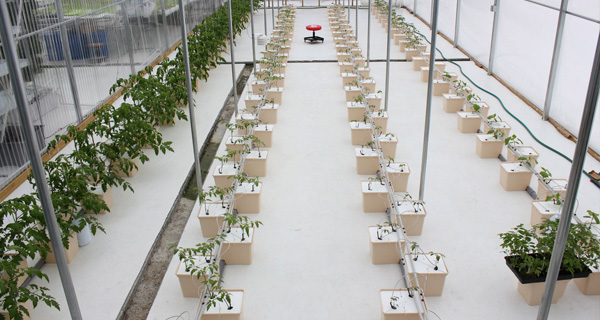Hydroponic Bucket System
You are on Page 2 of our ten page series on hydroponic bucket systems. Click on any of the below pages to jump to that page.
Page 1 Page 2 Page 3 Page 4 Page 5 Page 6 Page 7 Page 8 Page 9 Page 10

A commercial-scale bucket system for tomatoes. Several different growing phases are represented here, from young seedlings to plants on the verge of production. This particular system's components are available from Cropking.com.
Advantages
Despite all the different variations, the most common use of bato buckets is the flood and drain approach we described earlier. We’ll stick with that description for most of the rest of our discussion, but we’ll call out the details of other variations as they come up. So with that caveat in mind, what are the advantages of a hydroponic bucket system? Several come to mind:
First and foremost, the bucket system is very well suited to large plant production. Some would argue that the bucket system is the single best option for large vine production (tomatoes, cucumbers, melons, squash, etc) at any scale of operation. Indeed the bucket system is most commonly used for producing those crops and it does so extremely cost effectively. The buckets provide enough root volume to ensure nutrient uptake, and the location of the buckets on the floor or ground help make the maturing crop easy to reach. That location also eliminates any sort of supporting framework for the buckets themselves (although the vines do still need to be trellised). Spacing between the individual buckets can be varied to provide optimal spacing not only for plant growth and airflow, but also for employee access. While crops are generally not germinated in bato buckets, theoretically they could be. If nothing else, the bato buckets can be crowded together for young plants, possibly in a separate growing area suited to fostering such young specimens, then moved into the production area without being transplanted.
Another advantage of this system is that it’s almost infinitely scalable. If you like the approach, you can use it for one bucket or for thousands. If a grower wants to experiment with the system, he or she would easily be able to start with a few buckets, and then scale up if/whenever desired. Similarly, if a grower wants to cut back production, any number of bato buckets could be taken out of production without dramatically impacting the rest of the operation. The drip irrigation system would need to be expanded or contracted, as would the drain line (if one is used). If the system relies on a reservoir, a larger system would need a larger capacity reservoir or perhaps a second tank. If an injection system is used, the system would just need to be adjusted for the different production volume. We’ll talk more about this scalability issue a little further on.
Third, bato buckets can provide good to excellent protection against transmission and spread of some forms of disease, particularly root disease. The value of this particular advantage depends upon the crop, since some crops are more at risk from root borne disease than others. While disease transmission, spread and control is affected by many variables, it’s handy to be able to remove a single diseased bucket to protect nearby plants, without disturbing those other plants. Bato buckets are almost unique in this respect since the root mass for the plant(s) in each bucket is completely isolated from its neighbors.
That brings us to the next advantage. Aside from disease, a grower may have a variety of other reasons to want to swap plants in or out of a growing system. Most major hydroponic systems – flood and drain, NFT, floating raft – all risk root damage when one or more plants are removed. Again, some operations will rarely ever use this option, while other operations may rely heavily upon this characteristic. Either way, it’s nice to have this option.
Back to the topic of disease control, bato buckets offer the enviable advantage of being easy to clean and reuse between growing seasons. Depending on which growing media is used, the growing media can either be completely replaced (for instance with rockwool, coir, or perlite/vermiculite) and/or sterilized along with the bucket (for instance, with lava rock or sand/gravel). This may not be a huge issue for hobbyist growers, but being able to sterilize growing materials can translate into huge cost savings for larger operations.
Last but not least, hydroponic bucket systems allow for perfectly balanced nutrients to every single plant, even for mixed plantings. Again, this may not be a huge issue for hobby growers who simply want to deliver a general nutrient solution to a variety of plants. For commercial growers, this precise delivery characteristic allows a grower to dial in optimized nutrient solutions for each stage of a plant’s life cycle. That helps make optimize each stage of the plant’s growth, as cost effectively as possible.
BACK NEXT
Click any of the following links to jump to that page:
Page 1 Page 2 Page 3 Page 4 Page 5 Page 6 Page 7 Page 8 Page 9 Page 10